Artículos SCI
2017
2017
Reactividad de Sólidos
Preparation of ytterbium substituted BiFeO3 multiferroics by mechanical activation
Gil-Gonzalez, E; Perejon, A; Sanchez-Jimenez, PE; Hayward, MA; Perez-Maqueda, LAJournal of the European Ceramic Society, 37 (2017) 945-954
Show abstract ▽

Samples in the system Bi1-xYbxFeO3 (0.02 <= x <= 0.07) have for the first time been prepared by mechanical activation followed by sintering. XRD and DSC measurements show that the solubility limit of ytterbium in the R3c Bi1-xYbxFeO3 system is reached at x similar to 0.03. Higher ytterbium contents lead to a two-phase mixture of a main R3c phase of approximate composition Bi0.97Yb0.03FeO3 and ytterbium enriched secondary phases that cannot be readily indexed or quantified due to their small amount. DSC and temperature-dependent XRD showed that while the magnetic ordering temperature, T-N, was unaffected by Yb substitution, the ferroelectric ordering, T-C, declined. Temperature-dependent XRD patterns show that all samples exhibit rhombohedral R3c to orthorrhombic Pnma phase transitions. Diffuse reflectance spectroscopy suggests the potential use of the samples in photocatalytic applications due to their low band gap energy. Impedance spectroscopy and magnetic measurements show that samples are electrically homogenous and highly insulating, exhibiting antiferromagnetic behaviour at room temperature.
Febrero, 2017 | DOI: 10.1016/j.jeurceramsoc.2016.09.014
Reactividad de Sólidos
Processing and characterization of surrogate nuclear materials with controlled radial porosity
Torres, Y; Garcia-Ostos, C; Arevalo, C; Gotor, FJ; Pavon, JJ; Trueba, P; Rodriguez-Ortiz, JAJournal of Nuclear Science and Technology, 54 (2017) 167-173
Show abstract ▽

Irradiated fuel pellets present radial gradient porosity. CeO2 has been proven as a surrogate material to understand irradiated mixed oxide (MOX) due to its similar structural and mechanical properties. A novel compaction device was developed to produce CeO2 cylindrical pellets with controlled radial porosity. Three blends of CeO2 with different binder contents (0.5, 3 and 7.5 vol.% of ethylene-bis-stearamide, EBS) were prepared and used to obtain three different porosities for the core, intermediate and outer rings of pellets, respectively. Different compaction pressures were employed in each region to get the intended porosities. The whole pellet was subjected to a heating rate up to 500 degrees C to remove the EBS binder. Finally, a pressureless sintering step was performed at 1700 degrees C for 4 h. A microstructural characterization was performed in the three areas, including grain size and porosity. Mechanical properties like hardness, fracture toughness and tribo-mechanical response, as scratch resistance, were also determined. Pellets fabricated from this device have shown microstructural and mechanical properties with a good correlation to those of irradiated nuclear fuel.
Febrero, 2017 | DOI: 10.1080/00223131.2016.1222918
Materiales y Procesos Catalíticos de Interés Ambiental y Energético
Identification of Outer and Inner Nickel Particles in a Mesoporous Support: How the Channels Modify the Reducibility of Ni/SBA-15 Catalysts
Rodriguez-Gomez, A; Caballero, AChemnanomat, 3 (2017) 94-97
Show abstract ▽

Two different nickel supported on SBA-15 catalytic systems have been prepared by means of impregnation (Ni/SBA-15-ImU) and deposition-precipitation (Ni/SBA-15-DP) methodologies. Upon calcination, Ni/SBA-15DP presents a well-developed nickel phyllosilicate phase, which after reduction gives rise to a dispersed and homogeneous metallic phase, mainly located inside the 5 nm in diameter mesoporous structure of the support. On the contrary, as evidenced by XRD and a double temperature programmed reduction (TPR) peak, the Ni/SBA-15-ImU catalyst presents two different NiO phases, which after reduction in hydrogen generate nickel particles in a wide range of sizes. In situ XAS and XPS have unambiguously showed that the distinct TPR profiles obtained for each system are related with particles located in and out the mesoporous structure of the SBA-15 channels. The particles inside the porous are more difficult to reduce, clearly showing a kind of confinement effect of the SBA-15 mesostructure, modifying the reducibility of the NiO phase.
Febrero, 2017 | DOI: 10.1002/cnma.201600297
Reactividad de Sólidos
A new family of cermets: Chemically complex but microstructurally simple
de la Obra, AG; Aviles, MA; Torres, Y; Chicardi, E; Gotor, FJInternational Journal of Refractory Metals & Hard Materials, 63 (2017) 17-25
Show abstract ▽

Cermets based on Ti(C,N) have interesting properties, such as high wear resistance, high chemical stability and good mechanical strength at high temperature, but to become a viable alternative to cemented carbides, the fracture toughness and damage tolerance must be significantly improved. Complete solid-solution cermets (CSCs) have been proposed to further improve the mechanical properties of these materials. However, to develop this family of cermets with a high level of quality and reliability, using pre-fabricated complex carbonitrides is necessary instead of unalloyed mixtures as the raw ceramic material. A mechanochemical process called mechanically induced self-sustaining reaction (MSR) is suitable to obtain these complex carbonitrides with high stoichiometric control. On the other hand, high entropy alloys (HEAs), which can also be obtained by mechanochemical processes, are a good candidate to replace the current binder phase in cermets because they exhibit high strength and ductility at high temperature and good resistance to both wear and corrosion. In this work, a new family of CSCs based on (Ti,Ta,Nb)CxN1-x, with HEAs belonging to the Fe-Co-Ni-Cr-Mn-V system as the binder phase is developed by mechanochemical processes. With only two constituent phases, these cermets have a simple microstructure but a high compositional complexity because both the ceramic and binder phases are complex solid solutions with at least five components.
Febrero, 2017 | DOI: 10.1016/j.ijrmhm.2016.04.011
Nanotecnología en Superficies y Plasma
Preparation and Optimization of Fluorescent Thin Films of Rosamine-SiO2/TiO2 Composites for NO2 Sensing
Guillen, MG; Gamez, F; Suarez, B; Queiros, C; Silva, AMG; Barranco, A; Sanchez-Valencia, JR; Pedrosa, JM; Lopes-Costa, TMaterials, 10 (2017) art 124
Show abstract ▽

The incorporation of a prototypical rosamine fluorescent dye from organic solutions into transparent and microstructured columnar TiO2 and SiO2 (MO2) thin films, prepared by evaporation at glancing angles (GAPVD), was evaluated. The aggregation of the adsorbed molecules, the infiltration efficiency and the adsorption kinetics were studied by means of UV-Vis absorption and fluorescence spectroscopies. Specifically, the infiltration equilibrium as well as the kinetic of adsorption of the emitting dye has been described by a Langmuir type adsorption isotherm and a pseudosecond order kinetic model, respectively. The anchoring mechanism of the rosamine to the MO2 matrix has been revealed by specular reflectance Fourier transform infrared spectroscopy and infiltration from aqueous solutions at different pH values. Finally, the sensing performance towards NO2 gas of optimized films has been assessed by following the changes of its fluorescence intensity revealing that the so-selected device exhibited improved sensing response compared to similar hybrid films reported in the literature.
Febrero, 2017 | DOI: 10.3390/ma10020124
- ‹ anterior
- 201 of 420
- siguiente ›














